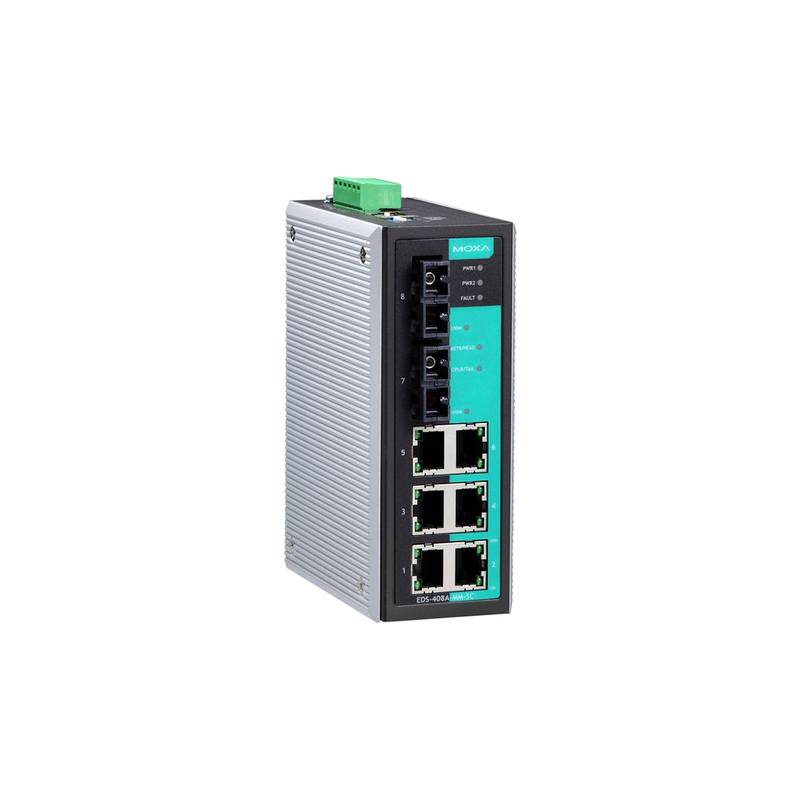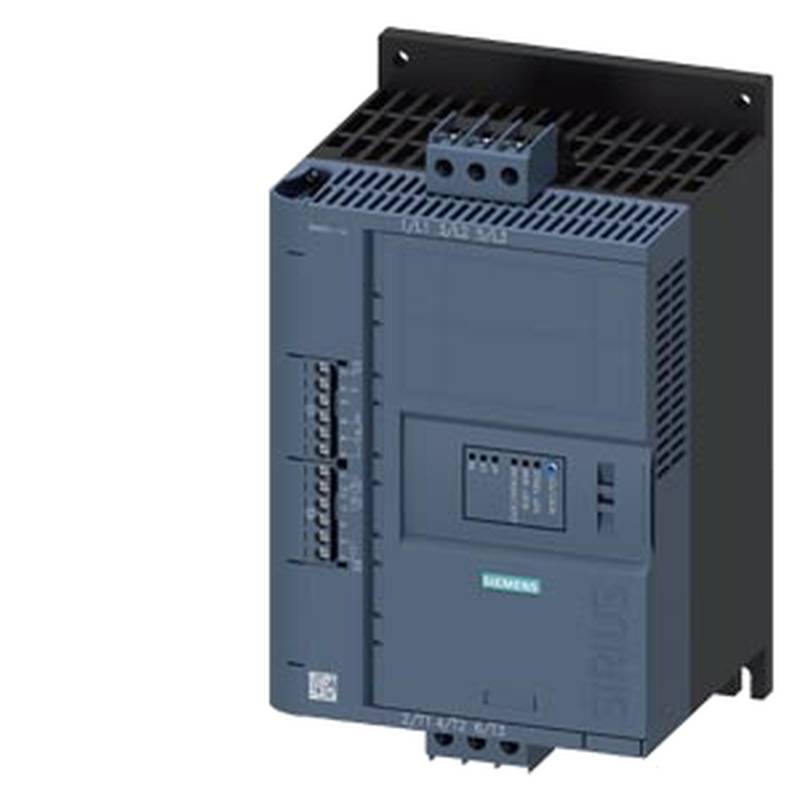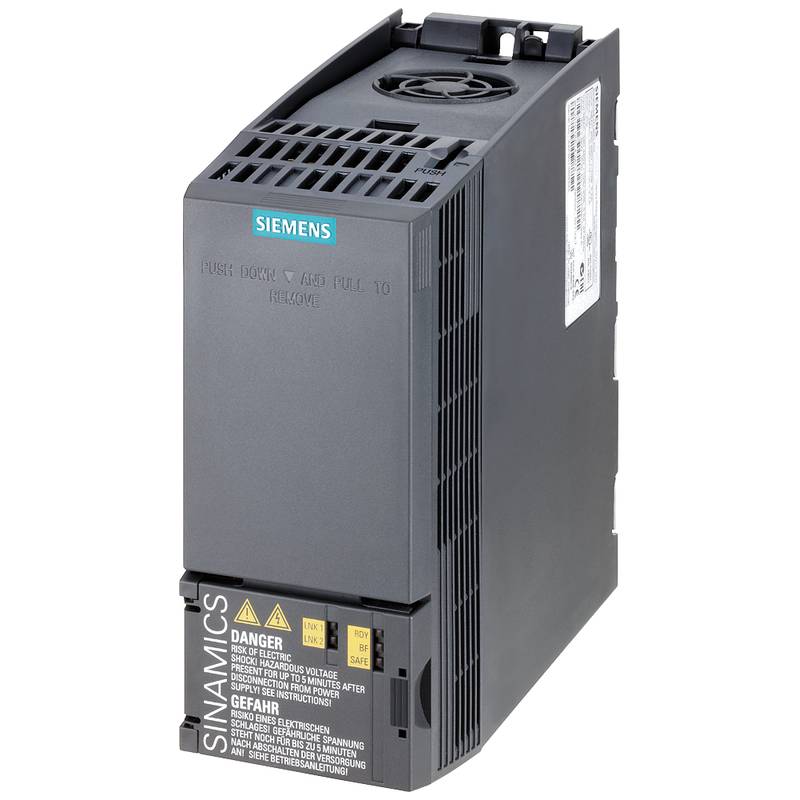
The Moxa EDS-408A-MM-ST is a robust industrial Ethernet switch designed for demanding environments, featuring eight Fast Ethernet ports with ST fiber connectors for long-distance, interference-free communication. Its key advantages lie in its industrial-grade reliability, dual power inputs for redundancy, and a wide operating temperature range, making it ideal for critical infrastructure and automation applications. Technical specifications highlight its support for 10/100BaseT(X) Ethernet, a -40 to 75°C operating temperature range, and DIN-rail mounting for easy integration.
Product Specifications
| Feature | Specification |
| :-------------------- | :-------------------------------------------------- |
| Ethernet Ports | 6 x 10/100BaseT(X) RJ45, 2 x 100BaseFX MM ST Fiber |
| Fiber Wavelength | 1300 nm |
| Fiber Distance | 2 km (Multi-Mode) |
| Power Input | 12/24/48 VDC (9.6 to 60 VDC) |
| Power Consumption | Max. 4.86 W |
| Operating Temperature | -40 to 75°C |
| Mounting | DIN-rail, Wall-mount (with kit) |
| Protocol Support | IEEE 802.3, 802.3u, 802.3x, 802.1D |
| Dimensions | 50 x 135 x 105 mm |
| Warranty | 5 years |
Core Features & Market Positioning
The Moxa EDS-408A-MM-ST carves a niche in the industrial networking market by prioritizing resilience and straightforward deployment for fiber-optic connectivity. Its dual redundant power inputs significantly enhance system uptime by ensuring continuous operation even if one power source fails, a critical requirement in many automation scenarios. The inclusion of ST connectors simplifies integration with existing fiber infrastructure, while the multi-mode fiber support offers a cost-effective solution for moderate distances where high bandwidth is not paramount. Moxa's established reputation for industrial-grade hardware further solidifies its position as a reliable choice for applications demanding long-term performance in harsh conditions, differentiating it from less robust or consumer-grade alternatives.
Key Application Scenarios
This industrial fiber switch excels in scenarios demanding reliable data transmission over extended distances or in electrically noisy environments. Common applications include powering communication networks in manufacturing plants, utility substations, transportation systems, and intelligent transportation systems (ITS). The multi-mode ST fiber ports are particularly well-suited for connecting control systems, PLCs, and sensors within a facility or across different buildings where standard copper Ethernet limitations are a concern. Its rugged design ensures stable operation in sectors like oil and gas, mining, and water/wastewater treatment.
Practical System Integration Guidance
Integrating the Moxa EDS-408A-MM-ST into an industrial network is typically straightforward. For power, connect a suitable DC power source (12/24/48 VDC) to the provided terminal block, ensuring polarity is observed. For network connectivity, standard Ethernet cables connect to the RJ45 ports, while the included multi-mode ST fiber optic patch cords link the ST ports to other fiber-enabled devices or backbone network segments. The switch supports auto-negotiation for speed and duplex, simplifying initial setup. Basic network configuration, such as setting IP addresses for management, can be accessed via Moxa's embedded web console or utility software.
Operation and Risk Mitigation
Operating the Moxa EDS-408A-MM-ST requires attention to environmental conditions and power supply stability. Ensure the operating temperature remains within the specified -40 to 75°C range and that the unit is properly ventilated. Utilize the dual power inputs to enhance system resilience against power outages. While the switch is designed for high reliability, potential issues might include fiber connection integrity; regularly inspect fiber optic cables and connectors for damage or dirt. Fault indicators on the unit, such as LED status lights for link, activity, and power, provide immediate visual feedback for troubleshooting.
Scalability & Long-Term Value
The Moxa EDS-408A-MM-ST offers a foundational element for scalable industrial networks. Its multiple Fast Ethernet ports allow for the aggregation of numerous devices, and its fiber uplink capability supports expansion to more remote locations or higher-bandwidth backbone segments. Compatibility with standard industrial protocols ensures seamless integration with existing SCADA, DCS, and PLC systems. As industries move towards Industry 4.0 and IIoT, the EDS-408A-MM-ST can serve as a reliable edge device, bridging legacy equipment with modern digital platforms and providing the necessary network infrastructure for data acquisition and remote monitoring.
FAQs
What are the primary benefits of using the Moxa EDS-408A-MM-ST?
This industrial switch offers robust performance in harsh environments, featuring a wide operating temperature range. Its dual redundant power inputs ensure high availability and minimize downtime. The ST fiber interfaces provide long-distance, noise-immune connectivity essential for many industrial settings.
The unit's industrial-grade design guarantees reliable operation in challenging conditions. It supports essential networking protocols for seamless integration into existing automation systems. Its compact form factor and DIN-rail mounting simplify installation within control cabinets.
This Moxa switch is designed for longevity, reducing the total cost of ownership over its operational lifespan. Its inclusion of both copper and fiber ports offers flexible deployment options for various network architectures.
How does the ST interface on the Moxa EDS-408A-MM-ST differ from other fiber connectors?
The ST connector is a bayonet-style fiber optic connector, known for its ease of use and secure locking mechanism. It is commonly used in multi-mode fiber applications and offers reliable connections in industrial settings. Its physical design makes it resilient to vibration and accidental disconnections.
Compared to LC or SC connectors, ST connectors can be slightly larger but are often favored for their robust construction and quick mating/unmating process. They are well-suited for applications where frequent connection/disconnection might occur.
The ST interface on this Moxa switch ensures compatibility with a wide range of multi-mode fiber optic cables and equipment that also utilize ST connectors, facilitating straightforward network expansion.
What are the typical distance limitations for the fiber ports on this switch?
The multi-mode fiber ports on the Moxa EDS-408A-MM-ST typically support distances up to 2 kilometers. This is a standard range for multi-mode fiber operating at 100 Mbps, suitable for campus networks or large factory floors.
When deploying, ensure the use of appropriate multi-mode fiber optic cabling (e.g., OM1, OM2, OM3) to achieve the rated distance. Signal degradation can occur over longer distances or with lower-grade fiber.
For applications requiring distances beyond 2 km, consider Moxa switches with single-mode fiber options or external media converters designed for longer reach.
Can the Moxa EDS-408A-MM-ST be managed remotely?
Yes, the Moxa EDS-408A-MM-ST supports remote management capabilities through its embedded web console. Network administrators can access configuration settings, monitor status, and perform diagnostics from a central location.
It is often integrated with Moxa's network management software, such as Moxa's MXview, which allows for centralized monitoring and management of multiple network devices across an industrial network. This simplifies network administration and fault detection.
Remote management is crucial for industrial environments where physical access to network equipment may be difficult or time-consuming. It enables proactive maintenance and rapid troubleshooting, minimizing operational disruptions.
What kind of power supply is required for the Moxa EDS-408A-MM-ST?
This industrial switch requires a DC power input, supporting a wide voltage range from 9.6 VDC to 60 VDC. This flexibility allows it to be powered by various industrial power sources, including 12 VDC, 24 VDC, or 48 VDC systems.
It features dual power inputs for redundancy. Connecting two separate power sources enhances system reliability, ensuring uninterrupted operation if one power supply fails. This is a critical feature for mission-critical applications.
Ensure that the power supply used meets the necessary safety and quality standards for industrial environments. Proper wiring and grounding are essential for safe and stable operation.
How is the Moxa EDS-408A-MM-ST typically mounted in an industrial cabinet?
The Moxa EDS-408A-MM-ST is designed for easy installation on a standard 35mm DIN-rail. This is a common mounting standard in industrial control cabinets, allowing for quick and secure attachment of various electrical components.
Optional wall-mounting kits are also available, providing flexibility in deployment locations outside of standard DIN-rail setups. This can be useful for surface mounting on walls or panels.
Proper mounting ensures the switch is securely fixed, preventing dislodgement due to vibration or physical impact, and facilitates proper airflow for cooling.
What are the advantages of using fiber optic ports over copper ports in industrial settings?
Fiber optic ports offer immunity to electromagnetic interference (EMI) and radio frequency interference (RFI), which are prevalent in industrial environments with heavy machinery and electrical equipment. This ensures cleaner data transmission.
Fiber optic cables can transmit data over much longer distances compared to copper cables without significant signal loss. This is essential for connecting equipment across large facilities or between buildings.
Fiber optic cables are also non-conductive, providing electrical isolation between connected devices. This enhances safety by preventing ground loops and protecting equipment from voltage surges.
Does this switch support any advanced network management features?
The Moxa EDS-408A-MM-ST supports basic network management features through its web interface and utility software. This includes device status monitoring, port configuration, and event logging.
For more advanced management, it can be integrated into broader network management systems like Moxa's MXview. This provides centralized control, topology mapping, and proactive fault alerts for multiple devices.
While it doesn't typically feature advanced Layer 3 routing or complex QoS configurations, it provides the essential management tools needed for reliable industrial Ethernet operation and network health monitoring.
What is the typical lifespan or warranty period for this industrial switch?
Moxa typically offers a comprehensive warranty for its industrial networking products, often extending to five years. This reflects the company's confidence in the durability and reliability of its hardware.
The industrial-grade components and robust construction of the EDS-408A-MM-ST are designed for long-term operation in demanding environments, contributing to a high mean time between failures (MTBF).
A longer warranty period reduces the total cost of ownership by minimizing potential replacement costs and downtime over the product's operational life.
What troubleshooting steps can be taken if the fiber ports are not connecting?
First, visually inspect the ST fiber optic connectors and cables for any physical damage, dirt, or debris. Clean connectors using appropriate fiber optic cleaning tools if necessary.
Verify that the correct type of multi-mode fiber cable is used and that it is compatible with the switch's specifications. Ensure the fiber cable is securely seated in both the switch port and the connected device's port.
Check the LED status indicators on the switch for the fiber ports. If the link light is off or amber, it indicates a problem with the physical connection, cable integrity, or the remote device's fiber port.

























